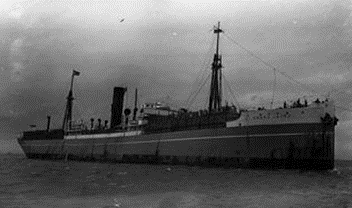The 4,364 ton steamship ‘Royal Crown’ was launched in Newcastle in 1927. She was a freighter, operated by Hall Brothers of Newcastle.
On 30th January 1940 she was attacked by a German bomber in the North Sea, about 20 miles off Great Yarmouth. The Germans dropped three bombs but missed, so machine-gunned the decks. The ship had her own gun, but the gunner was killed. Another bomb hit the ship, exploded in the engine room, stopped the engines and destroyed two lifeboats. With four of the crew already dead, the survivors took to the two remaining lifeboats. One boat was rowed to shore but capsized in the rough sea and seven men were drowned. The other boat was never found. Of the 37 crewmen, only 15 survived. The crew mostly lived in Hull or South Wales, although several of them had Indian names.

Three days later the Royal Crown washed up on the coast, south of Lowestoft, still on fire. Members of the Auxiliary Fire Service took to boats to put the fire out. A month later she was towed to port (probably Newcastle) for repair.
By early 1941 she was back in service, under a new master – Anthony Potts (the original master was amongst the 22 men lost in 1940).
On 15th March 1941 the German battleship Gneisenau and her sister ship Scharnhorst found a dispersed allied convoy in the Atlantic, off Newfoundland, and sank or captured four tankers. The next day they found stragglers from the convoy and the Gneisenau sank seven of them (probably by gunfire) including the Royal Crown. All the crew were rescued by the Gneisenau.
One of the surviving ships radioed a warning and two British battleships were sent to intercept the German raiders. The German ships escaped to Brest in occupied France, and later to Germany, but were repeatedly attacked by the RAF and the Gneisenau didn’t play an active role in the rest of the war. The Scharnhorst was repaired and used in operations off Norway until she was sunk by the battleship HMS Duke of York, with the cruiser HMS Belfast and their escort destroyers in the Battle of the North Cape in December 1943.
The master of the Royal Crown, Anthony Potts, was interned (presumably with the rest of the crew) in ‘Marlag und Milag Nord’ prisoner of war camp, near Bremen, Germany. The camp was liberated by the British Army in May 1945.




